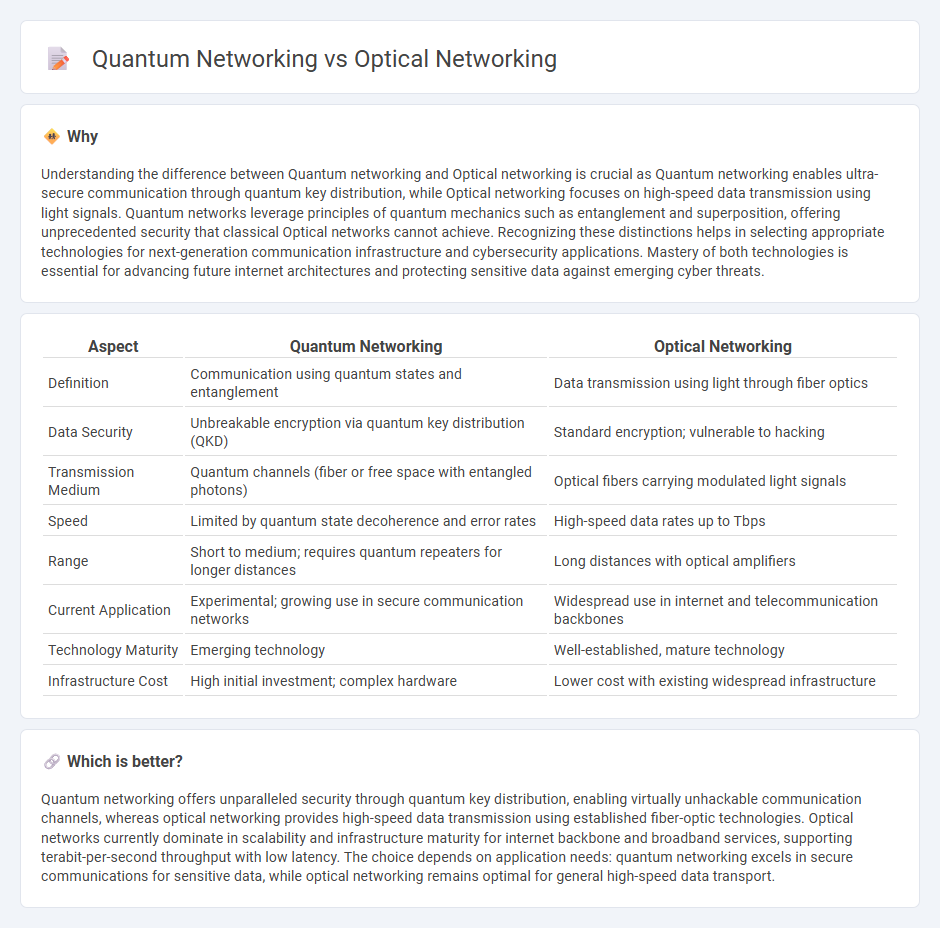
Quantum networking leverages the principles of quantum mechanics, such as entanglement and superposition, to enable highly secure communication and unprecedented data transmission speeds. Optical networking, on the other hand, relies on the use of light signals transmitted through fiber optic cables to deliver high bandwidth and low latency connections across vast distances. Explore the evolving landscape of these cutting-edge technologies to understand their impact on the future of global communication.
Why it is important
Understanding the difference between Quantum networking and Optical networking is crucial as Quantum networking enables ultra-secure communication through quantum key distribution, while Optical networking focuses on high-speed data transmission using light signals. Quantum networks leverage principles of quantum mechanics such as entanglement and superposition, offering unprecedented security that classical Optical networks cannot achieve. Recognizing these distinctions helps in selecting appropriate technologies for next-generation communication infrastructure and cybersecurity applications. Mastery of both technologies is essential for advancing future internet architectures and protecting sensitive data against emerging cyber threats.
Comparison Table
| Aspect | Quantum Networking | Optical Networking |
|---|---|---|
| Definition | Communication using quantum states and entanglement | Data transmission using light through fiber optics |
| Data Security | Unbreakable encryption via quantum key distribution (QKD) | Standard encryption; vulnerable to hacking |
| Transmission Medium | Quantum channels (fiber or free space with entangled photons) | Optical fibers carrying modulated light signals |
| Speed | Limited by quantum state decoherence and error rates | High-speed data rates up to Tbps |
| Range | Short to medium; requires quantum repeaters for longer distances | Long distances with optical amplifiers |
| Current Application | Experimental; growing use in secure communication networks | Widespread use in internet and telecommunication backbones |
| Technology Maturity | Emerging technology | Well-established, mature technology |
| Infrastructure Cost | High initial investment; complex hardware | Lower cost with existing widespread infrastructure |
Which is better?
Quantum networking offers unparalleled security through quantum key distribution, enabling virtually unhackable communication channels, whereas optical networking provides high-speed data transmission using established fiber-optic technologies. Optical networks currently dominate in scalability and infrastructure maturity for internet backbone and broadband services, supporting terabit-per-second throughput with low latency. The choice depends on application needs: quantum networking excels in secure communications for sensitive data, while optical networking remains optimal for general high-speed data transport.
Connection
Quantum networking leverages the principles of quantum mechanics to enable ultra-secure communication through quantum entanglement, while optical networking uses fiber optic cables to transmit data at high speeds using light signals. Both technologies rely on photons as information carriers, making optical fibers an essential infrastructure for implementing quantum key distribution and quantum communication protocols. Integration of quantum networking over existing optical networks promises enhanced data security and higher bandwidth efficiency in future telecommunication systems.
Key Terms
Photonic transmission
Optical networking relies on photonic transmission using classical light signals to enable high-speed data transfer through fiber optics, characterized by wavelength-division multiplexing and low attenuation. Quantum networking harnesses quantum photonic transmission, leveraging quantum entanglement and superposition for secure communication and quantum information processing across quantum channels. Explore deeper into the technologies driving the future of photonic transmission in communication networks.
Quantum entanglement
Quantum networking leverages quantum entanglement to enable secure communication channels that are fundamentally different from classical optical networking, which relies on light signals transmitted through fiber optics. Quantum entanglement allows instantaneous state correlation between particles over long distances, enhancing encryption methods and data integrity in quantum networks. Explore the cutting-edge principles and practical applications of quantum entanglement in networking to understand its transformative potential.
Qubit communication
Optical networking transmits data using photons through fiber optics, relying on classical bits encoded as light pulses, while quantum networking leverages qubits that harness superposition and entanglement for secure and efficient quantum communication. Qubit communication enables ultra-secure quantum key distribution and quantum teleportation, surpassing classical optical networks in speed and security. Explore advanced differences and emerging applications of qubit-based quantum networking for next-generation communication technologies.
Source and External Links
What Is Optical Networking? - Supermicro - Optical networking uses light to transmit data over optical fiber cables, enabling high-speed, long-distance communication with large bandwidth capacity and minimal signal loss, leveraging technologies like WDM and PON for scalable data traffic management.
Optical networking - Wikipedia - Optical networking transmits data encoded in light across fiber-optic cables or open space, supporting local to global networks with technologies such as fiber-optic networks and free-space optical networks used in telecommunications and satellite systems.
Optical Networks explained | Nokia.com - Optical networks rely on fiber optic glass strands to send laser pulses encoding data bits with ultra-low loss, requiring optical amplification to maintain signal integrity over long distances without converting light into electrical signals.
 dowidth.com
dowidth.com